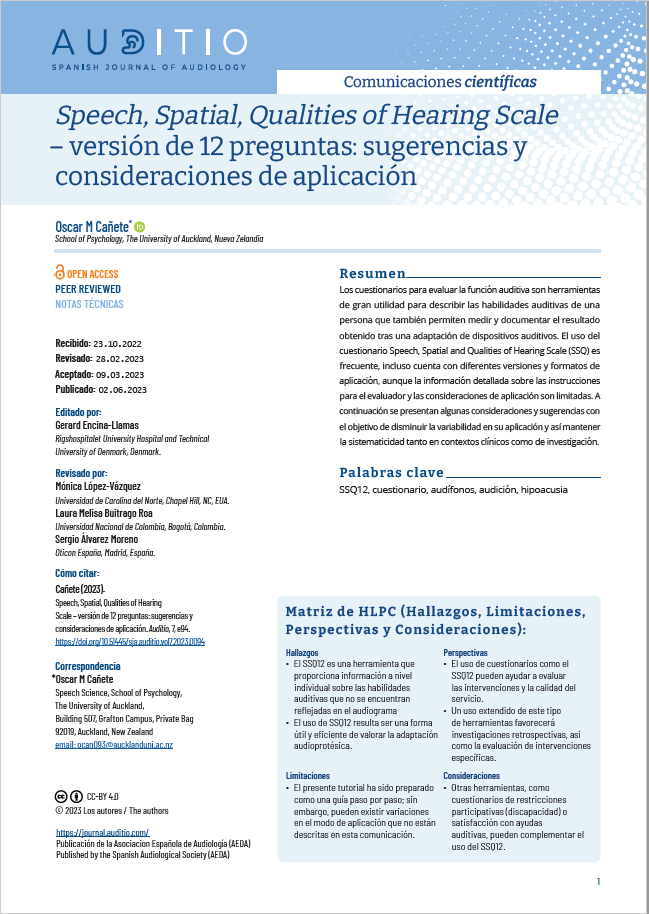Speech, Spatial, Qualities of Hearing Scale – versión de 12 preguntas: sugerencias y consideraciones de aplicación
DOI:
https://doi.org/10.51445/sja.auditio.vol7.2023.0094Palabras clave:
SSQ12, cuestionario, audífonos, audición, hipoacusiaResumen
Los cuestionarios para evaluar la función auditiva son herramientas de gran utilidad para describir las habilidades auditivas de una persona que también permiten medir y documentar el resultado obtenido tras una adaptación de dispositivos auditivos. El uso del cuestionario Speech, Spatial and Qualities of Hearing Scale (SSQ) es frecuente, incluso cuenta con diferentes versiones y formatos de aplicación, aunque la información detallada sobre las instrucciones para el evaluador y las consideraciones de aplicación son limitadas. A continuación se presentan algunas consideraciones y sugerencias con el objetivo de disminuir la variabilidad en su aplicación y así mantener la sistematicidad tanto en contextos clínicos como de investigación.
Descargas
Visibility and Altmetrics
Métricas
Estadísticas globales ℹ️
|
2923
Visualizaciones
|
21222
Descargas
|
|
24145
Total
|
|
Citas
ASHA Ad Hoc Committee on Hearing Aid Selection and Fitting, on Hearing Aid Selection, A. A. H. C., & Fitting. (1998). Guidelines for Hearing Aid Fitting for Adults. American Journal of Audiology, 7(1), 5. https://doi.org/10.1044/1059-0889.0701.05
Bamiou, D. E., Iliadou, V. V., Zanchetta, S., & Spyridakou, C. (2015). What can we learn about auditory processing from adult hearing questionnaires? Journal of the American Academy of Audiology, 26(10), 824–837. https://doi.org/10.3766/jaaa.15009
Cañete, O. M., Marfull, D., Torrente, M. C., & Purdy, S. C. (2022). The Spanish 12-item version of the Speech, Spatial and Qualities of Hearing scale (Sp-SSQ12): adaptation, reliability, and discriminant validity for people with and without hearing loss. Disability and Rehabilitation, 44(8), 1419–1426. https://doi.org/10.1080/09638288.2020.1795279
Cox, R. M. (2003). Assessment of subjective outcome of hearing aid fitting: getting the client’s point of view. International journal of audiology, 42 Suppl 1(SUPPL. 1). https://doi.org/10.3109/14992020309074629
Demeester, K., Topsakal, V., Hendrickx, J. J., Fransen, E., van Laer, L., van Camp, G., van de Heyning, P., & van Wieringen, A. (2012). Hearing disability measured by the speech, spatial, and qualities of hearing scale in clinically normal-hearing and hearing-impaired middle-aged persons, and disability screening by means of a reduced SSQ (the SSQ5). Ear and Hearing, 33(5), 615–626. https://doi.org/10.1097/AUD.0b013e31824e0ba7
Galvin, K. L., & Noble, W. (2013). Adaptation of the speech, spatial, and qualities of hearing scale for use with children, parents, and teachers. Cochlear implants international, 14(3), 135–141.
Gatehouse, S., & Noble, I. (2004). The Speech, Spatial and Qualities of Hearing Scale (SSQ). International Journal of Audiology, 43(2), 85–99. https://doi.org/10.1080/14992020400050014
Jensen, N. S., Akeroyd, M., Noble, W., & Naylor, G. (2009). The Speech, Spatial and Qualities of Hearing scale (SSQ) as a benefit measure. NCRAR conference on The Ear-Brain System: Approaches to the Study and Treatment of Hearing Loss.
Kiessling, J., Grugel, L., Meister, H., & Meis, M. (2011). German translations of questionnaires SADL, ECHO and SSQ and their evaluation. Zeitschrift fur Audiologie, 50, 6–16.
Moulin, A., Vergne, J., Gallego, S., & Micheyl, C. (2019). A new speech, spatial, and qualities of hearing scale short-form: Factor, cluster, and comparative analyses. Ear and Hearing, 40(4), 938–950. https://doi.org/10.1097/AUD.0000000000000675
Noble, W., Jensen, N. S. S., Naylor, G., Bhullar, N., & Akeroyd, M. A. (2013). A short form of the Speech, Spatial and Qualities of Hearing scale suitable for clinical use: The SSQ12. International journal of audiology, 52(6), 409–412. https://doi.org/10.3109/14992027.2013.781278
Obuchi, C., & Kaga, K. (2020). Development of a questionnaire to assess listening difficulties in adults with auditory processing disorder. Hearing, Balance and Communication, 18(1), 29–35. https://doi.org/10.1080/21695717.2019.1663055
Tharpe, A. M. (2004). Who has time for functional auditory assessments? We all do! Volta Voices., 11(7), 10–12. http://search.ebscohost.com/login.aspx?direct=true&db=cin20&AN=106588246&site=ehost-live
von Gablenz, P., Otto-Sobotka, F., & Holube, I. (2018). Adjusting Expectations: Hearing Abilities in a Population-Based Sample Using an SSQ Short Form. Trends in Hearing, 22. https://doi.org/10.1177/2331216518784837
Wong, L., & Hickson, L. (2012). Evidence-based practice in rehabilitative audiology evaluating: interventions for children and adults with hearing impairment. Plural Publishing.

Publicado
Cómo citar
Número
Sección
Categorías
Licencia
Derechos de autor 2023 Oscar M. Cañete

Esta obra está bajo una licencia internacional Creative Commons Atribución 4.0.
Todos los artículos serán publicados bajo la licencia abierta Creative Commons Attribution (CC-BY). Esta licencia permite a otros compartir y adaptar el contenido, incluso con fines comerciales, siempre que se dé el reconocimiento adecuado a los autores y a la revista. Al enviar su manuscrito, los autores retienen los derechos de autor pero otorgan a la revista el derecho a realizar la primera publicación bajo esta licencia.
Más información sobre esta licencia disponible en: https://creativecommons.org/licenses/by/4.0/
Publicaciones 2001-2020
Los textos publicados en esta revista en la seccion de "AUDITIO 2001-2020 están sujetos –si no se indica lo contrario– a una licencia de Reconocimiento 3.0 España de Creative Commons. Puede copiarlos, distribuirlos, comunicarlos públicamente, hacer obras derivadas y usos comerciales siempre que reconozca los créditos de las obras (autoría, nombre de la revista, institución editora) de la manera especificada por los autores o por la revista. La licencia completa se puede consultar en http://creativecommons.org/licenses/by/3.0/es/deed.es.








 AUDITIO | Spanish Journal of Audiology
AUDITIO | Spanish Journal of Audiology
